Working from home has fundamentally transformed the way we utilize our living spaces. Our personal and work lives now coexist in the same environment, making effective organization of our home office essential. A tidy and well-planned workspace is not just about appearances; it is vital for maintaining productivity and balance while working remotely.
15 Best Home Office Organization Tips
| Tip | Explanation |
|---|---|
| Designate a dedicated workspace | Create clear boundaries between work and personal life by setting up a specific work area. This improves focus and prevents burnout. |
| Declutter regularly | Maintain a clean, distraction-free environment by getting rid of unnecessary items and organizing your space weekly. |
| Use vertical storage | Maximize space efficiency by installing wall-mounted shelves, pegboards, or hanging organizers to keep your desk clear. |
| Sort items into categories | Use ‘Keep,’ ‘Donate/Discard,’ and ‘Relocate’ piles to declutter efficiently and ensure everything has its place. |
| Set up task-specific zones | Create separate areas for computer work, paperwork, and brainstorming to streamline workflow and minimize distractions. |
| Digitally declutter | Organize digital files into clearly labeled folders, delete unnecessary documents, and regularly back up important data. |
| Manage cables effectively | Use cable ties, clips, and sleeves to prevent tangled cords, making your workspace look tidier and safer. |
| Establish a charging station | Set up a dedicated charging station with a surge protector to centralize and organize device charging. |
| Implement cloud storage | Use Google Drive, Dropbox, or OneDrive for secure file storage and easy access across multiple devices. |
| Invest in multi-purpose furniture | Choose desks with built-in drawers, foldable tables, or modular shelving to optimize storage in small spaces. |
| Build a daily tidying habit | Spend 5 minutes at the end of each workday clearing your desk, filing papers, and resetting your workspace. |
| Schedule deep-cleaning sessions | Set aside weekly and monthly organization sessions to reassess your workspace and maintain long-term order. |
| Use a planner or bullet journal | Track work progress, to-dos, and deadlines using a system that keeps you accountable and organized. |
| Create a tech inventory | Maintain a list of devices, software, and login credentials to keep track of your digital tools and prevent loss. |
| Embrace flexibility | Allow your organization system to evolve as your needs change, keeping it practical and easy to maintain. |
The Impact of a Dedicated Workspace
Workplace boundaries become more effective when you establish a designated working area. Your workstation functions as the official workspace because when you occupy your seat you transition into work mode. You can fully detach yourself from work after leaving your designated workspace. Maintaining separate mental space enables people to avoid burnout. The brain struggles to concentrate because it must process work tasks while dealing with visual clutter in an untidy environment according to scientific studies.
Remote work became the new standard for most organizations during the COVID-19 pandemic. Work from home was a rare practice before COVID-19 since only twenty percent of employees did it. By December 2020, that number jumped to 71%. The quick shift exposed the essential role of having an appropriate home workplace setup. Remote workers faced difficulties finding suitable work areas since 25% among them experienced this problem.
Learn more about home office ergonomics
From Chaos to Calm: The Benefits of Organization
A tidy home office does more than boost productivity – it can spark creativity and lift your mood. Your workspace reflects your mindset. When your desk is organized, your thoughts tend to be clearer too. By creating a space that works well and looks good, you set yourself up for better focus and inspiration.
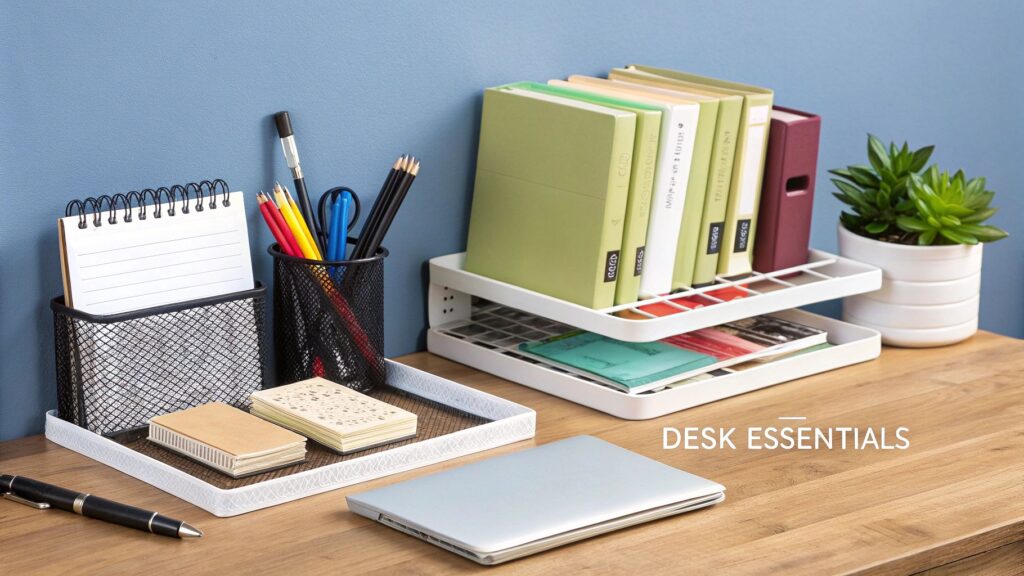
Long-Term Impact on Career Success
Good home office organization can help your career growth too. A well-kept workspace shows you’re professional and detail-oriented – qualities that matter in any field. When you invest time in organizing both your physical space and digital files, you build habits that support your career goals. Smart organization and time management work together to help you succeed professionally.
Decluttering Your Home Office Space
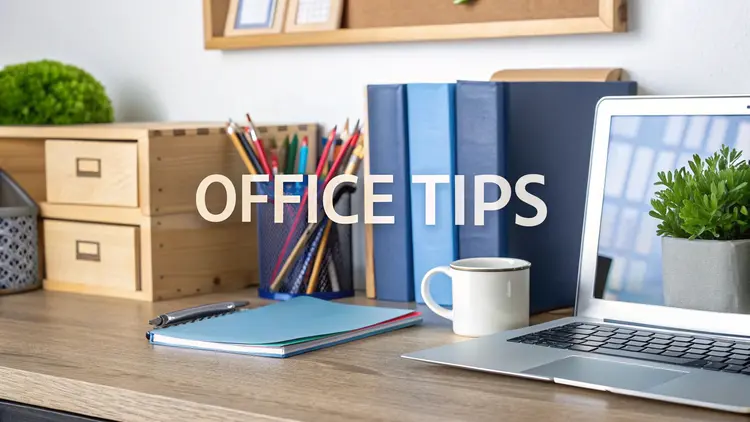
Getting your home office in order can feel like a huge task. Did you know the average American home has around 300,000 items? What’s even more surprising is that we only use about 20% of our stuff regularly. The other 80% just sits there gathering dust. We end up spending roughly 3,680 hours of our lives searching for misplaced things. Check out these eye-opening stats about home organization. Let’s walk through some practical ways to take back control of your workspace.
Evaluating Your Workspace
The first step requires you to empty all contents from your drawers as well as shelves and cabinets. The complete view of your items helps you grasp what resources you have at hand. Use this opportunity to thoroughly clean the surfaces when everything is taken out of its place. Working through this process allows you to implement a fresh start for your workspace.
The Power of the Purge
The exciting task of sorting begins as you review all items. Make three simple piles: Keep, Donate/Discard, and Relocate. Be honest with yourself. Six months of non-use and lack of work efficiency mean you should consider discarding whatever item it is. Having a clutter-free environment results in feelings of great satisfaction despite the initial challenges of the process.
Creating Zones for Success
After clearing away additional items you should consider your office workflow patterns. Different workspace zones should be established for distinct activities including a silent area for computers and paper-based work and a creative area for brainstorming. Your work efficiency increases when you establish separate areas for each task because it maintains your focus.
Digital Decluttering: A Must-Do
Digital disorganization creates the same type of slowdown as physical mess does. Delete unnecessary files from your computer and remove old documents while unsubscribing from useless email notifications. Additional support to maintain order exists for anyone who needs it. Check out how bullet journaling can help you keep track of everything. When both your physical and digital spaces are tidy, you’ll feel more in control and ready to tackle anything.
Smart Storage Solutions That Transform Your Space
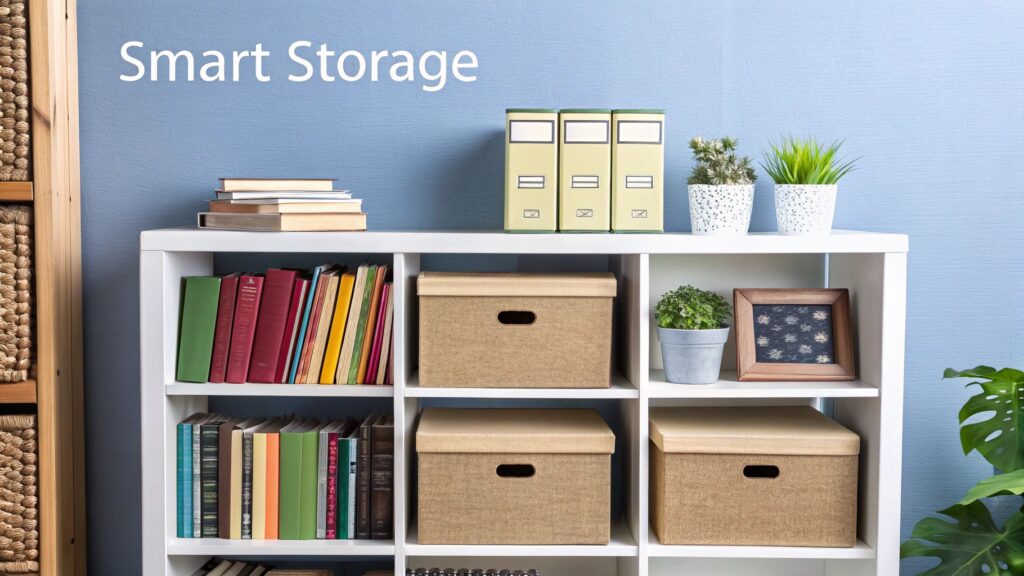
After you complete your decluttering process you should establish storage solutions which optimize your available space. Home office organization extends far beyond basic filing cabinets since numerous inventive storage solutions exist for this space. You should utilize wall space effectively with shelves and hanging organizers to create more room for yourself on your desk along with your floor.
Identifying Hidden Storage Opportunities
Your office contains hidden potential because you should explore its unused areas for optimization. The wall space becomes ideal for floating shelves while the door needs an over-door organizer and the desk area works best for rolling storage containers.
Your current office furniture holds many hidden storage potential options including built-in drawers and adjustable shelves which generate numerous storage areas.
Choosing the Right System for Your Needs
Home offices differ from one another so there exists no universal storage solution which works perfectly for every space. Determine a strategy according to the requirements of your workflow routine and how your space looks and the funds you have available.
Multi-purpose furniture with vertical storage works best for small offices but larger spaces allow dedicated areas for different activities. Current trends demonstrate the increasing importance of home organization because the industry generated $11.4 billion in revenue in 2021 and expects a 4% annual increase from 2025 to 2025.
See more stats here: Home Organizing Industry Growth
DIY vs. Premium Solutions: Making Informed Decisions
You don’t have to spend a fortune to get organized.
Simple DIY solutions like using mason jars for supplies or repurposing boxes for files can work great. But for trickier storage challenges, investing in quality solutions like modular shelving or custom cabinets might make sense. The best approach combines affordable basics with smart splurges on key pieces that will make a real difference in your daily workflow. Focus on what matters most for your needs and budget.
Building Systems That Actually Work
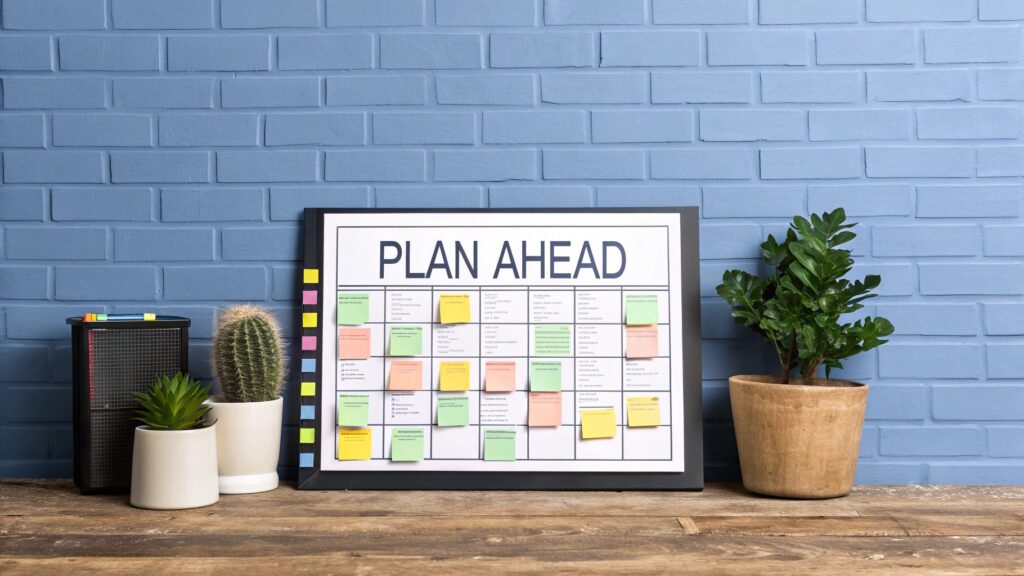
You have mastered decluttering and storage methods and now need to establish systems which will turn your home office organization into a standard practice instead of occasional cleaning. Your goal should be to develop operational systems that align with your natural work methods and support your tight schedule.
Designing Workflows for Your Work Style
Consider how you work naturally. Your work method includes viewing everything through color-coded files alongside labeled containers. You need to decide whether a neat minimalist space with digital storage suits your needs more than a system with visible organization. Your organizational system needs to reflect the way you prefer to work. Your need to switch locations often would benefit from using cloud storage rather than physical cabinets.
Managing Physical and Digital Workflows
Excellent organization requires physical solutions alongside digital solutions. Create a specific area for incoming mail and papers before processing them at regular intervals. Important documents will remain accessible due to this approach. The digital system should match your clear organization by using meaningful folder structures and naming files effectively and performing regular backups.
Poor organization has real costs.
23% of adults pay late fees simply because they misplace their bills. Find more detailed statistics here. This shows why having solid systems is so important from day one.
Creating Flexible and Maintainable Systems
Your systems need to roll with the punches when life gets messy. Build in both quick daily habits (like a 5-minute desk cleanup) and deeper organizing sessions that happen less often. This two-part approach keeps things tidy day-to-day while allowing for bigger resets when needed. Want to start your day right? Check out these tips for How to master your mornings with a 5 am routine.
Avoiding Common System Failures
Complexity should be monitored when designing systems since detailed systems cause frustration that leads users to give up. Your system should remain basic while staying user-friendly for maintenance purposes. Also, don’t skip regular upkeep. To establish organization as a habit one must devote continuous attention to it.
Proactive planning of typical challenges helps you create durable systems that simplify your professional activities.
Mastering Tech Organization and Cable Management
A well-ordered tech setup can transform your home office from chaos to calm. Having everything organized not only creates a more pleasant workspace but also helps you work more efficiently and with less stress. Let’s look at the key areas to focus on.
Taming the Cable Jungle: Effective Cord Management
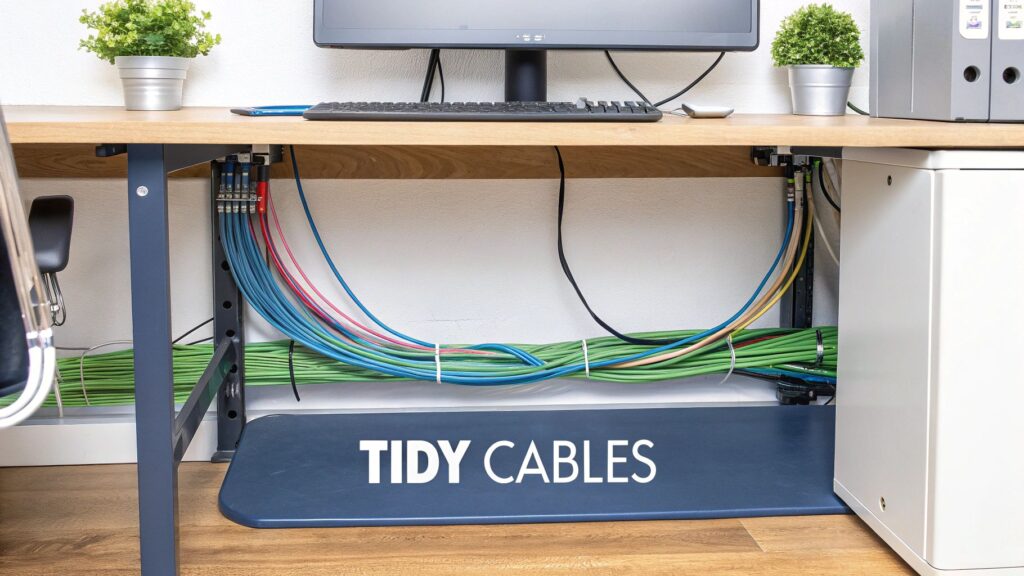
Nobody likes dealing with tangled cables sprawled across their desk. Beyond being an eyesore, they can actually be dangerous.
The good news?
Some simple tools can help. Cable ties, clips, and sleeves are essential for getting cords under control. Bundle related cables together with ties, use clips to guide them neatly along surfaces, and cover groups of cords with sleeves. This makes your space look cleaner and helps you quickly find the cable you need.
Centralizing Power: Charging Stations and Surge Protectors
When you work with multiple devices, having chargers scattered everywhere creates unnecessary clutter. Set up a dedicated charging station to keep all your power needs in one spot – no more hunting for chargers! Add a quality surge protector to keep your equipment safe. This setup gives you easy access to power while keeping cables neat and organized.
Optimizing Workspace Layout for Tech
Think carefully about where you place your tech tools. Keep items you use often within easy reach, and make sure your equipment has proper airflow to prevent overheating. Leave some extra space and power outlets available – you’ll likely add more devices over time. A bit of planning now saves headaches later.
Digital File Management: Going Paperless
You might be interested in: How to master productivity with a telephone answering service.
A disorganized computer system functions at the same pace as an unorganized desk. Establishing simple and organized file names alongside systematic folder structures helps maintain digital file order. Cloud storage provides both easy access and backup capabilities to your files. Paper documents should be scanned instead of being saved as physical copies because this approach both conserves space and improves document retrieval efficiency.
Creating a Tech Inventory
Making a tech inventory allows you to track down your equipment.
Create a single location that contains all your devices together with their software and essential login access information. A basic step will help you save significant time during equipment troubleshooting and system upgrade processes. A tech inventory functions as a clear guide for your setup because it shows both your equipment list and system relationships.
Creating Sustainable Organization Habits
A well-organized home office needs ongoing care to stay that way. Like tending a garden, sustainable organization requires regular attention, not just a one-time effort.
Let’s explore how to build simple routines that keep your space organized without feeling overwhelmed.
Understanding Your Work Style and Schedule
Know your natural work rhythm to make organization stick. Consider when you have the most energy – are you fresh and focused in the morning?
Or do you hit your stride later in the day? Match your tidying routines to your peak times. For example, if you’re a night owl, a quick evening cleanup might work better than forcing yourself to organize first thing.
Building Simple Daily Habits
Small actions done regularly beat occasional deep cleans. Add quick 5-minute organization bursts into your existing routine, such as:
- Clearing off your desk before leaving
- Filing papers right away
- Returning supplies to their spots
- Taking out trash daily
These mini-tasks prevent mess from building up. Think of it like daily teeth brushing – a simple habit that prevents bigger issues.
Developing Weekly and Monthly Routines
While daily upkeep helps, you also need deeper organizing sessions. Set aside a weekly 30-minute block for:
- Processing mail and papers
- Checking your task list
- Cleaning office equipment
Monthly, plan 1-2 hours for bigger tasks:
- Clearing old files
- Checking if storage still works
- Deep cleaning surfaces and drawers
This mix of quick daily habits and thorough monthly sessions keeps things running smoothly.
Tracking Progress and Staying Accountable
Progress tracking enables you to maintain your goal commitment like any other target. A basic checklist or planner or mobile application functions as an organization tracking system. Visible reminders create a positive momentum effect.
Your progress will improve significantly when you select an accountability partner to share your goals with a friend or colleague or family member who will offer support.
Embracing Imperfection and Adapting as Needed
Remember – perfect is the enemy of good. Life happens and spaces get messy sometimes. That’s okay. Focus on building flexible systems that work with your real life, not against it. Review your organizing methods regularly and adjust as needed. The best systems are ones you’ll actually use, so keep things simple and practical for your needs.
Looking to boost your productivity with better organization? Check out Lorelei Web for practical tips and resources to help entrepreneurs succeed through smart organization.

Lorelei has been an online entrepreneur, marketer and writer since 2006. Her biggest passion is WordPress, which is why she switched to being a full-time blogger 20 years ago and hasn’t looked back since. With so many years of experience behind her, she is an expert in copywriting, SEO, marketing and business strategies.






